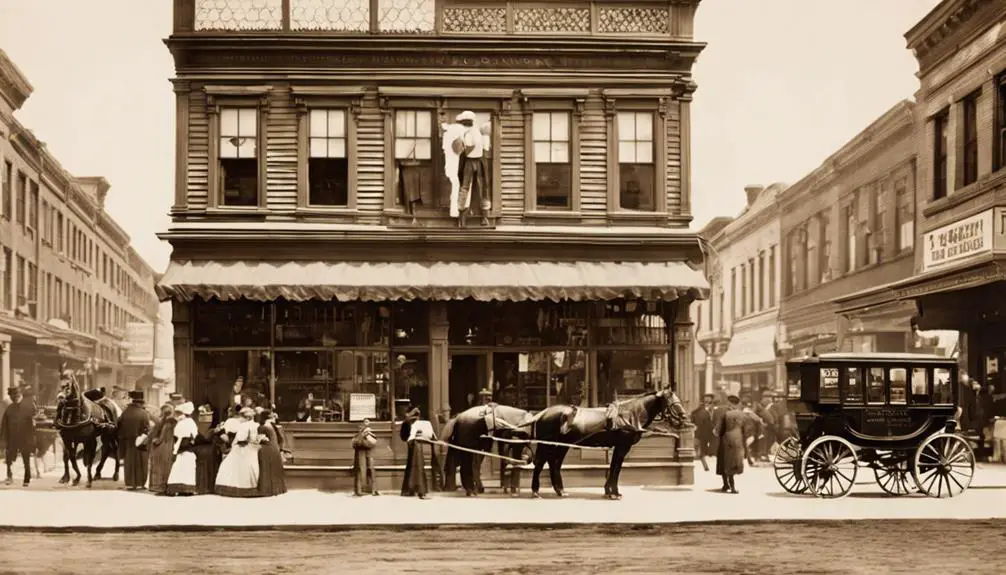J.C. Penney was founded on April 14, 1902, in Kemmerer, Wyoming. It started with a single store named The Golden Rule Store, showcasing a commitment to fairness and ethical retailing. The store's initial sales were $2,800, but expansion came quickly, with three stores by 1907 and a focus on customer satisfaction. By 1913, J.C. Penney officially incorporated, paving the way for nationwide growth. They moved their headquarters to New York City in 1914, marking a significant step in their journey. This rich history isn't just about stores; it's about a legacy that transformed retail in America. You might be curious about what happened next!
Founding of JCPenney

The founding of JCPenney marked a significant moment in retail history, driven by James Cash Penney's vision of customer service. On April 14, 1902, he opened the very first store in Kemmerer, Wyoming, originally named The Golden Rule Store. This name reflected his commitment to treating customers with respect and fairness, a principle that would become the backbone of the company's philosophy. With a modest annual sales figure of $2,800, Penney began to lay the groundwork for what would become a prominent retail chain.
By 1907, James Cash Penney had bought out his partners and expanded the business to three stores. His dedication to customer service paid off, as annual sales soared to $166,313. The journey didn't stop there. In 1913, the company was officially incorporated as J.C. Penney Company.
Recognizing the need for further growth, Penney relocated the headquarters to New York City in 1914, setting the stage for national expansion.
The company's growth was rapid. By 1912, JCPenney had reached 34 stores and achieved impressive annual sales of $2 million. Each new store not only contributed to the company's financial success but also allowed Penney to spread his customer-centric philosophy further across the nation.
This expansion marked the beginning of a significant growth trajectory, establishing JCPenney as a household name in American retail.
Early Business Philosophy
James Cash Penney's early vision for his retail business set the tone for a customer-focused environment that prioritizes integrity and fairness. When J.C. Penney opened his first store, The Golden Rule, in 1902, he emphasized customer-centric values that would redefine the retail industry. His business philosophy revolved around the principle of the "Golden Rule," which encouraged ethical practices and respectful treatment of both customers and employees.
One of the groundbreaking strategies Penney introduced was a "one-price" policy. This approach eliminated the need for haggling, ensuring transparency in pricing and fostering trust among shoppers. You'd find that this fair pricing model not only made shopping more accessible but also attracted a loyal customer base who appreciated the straightforward nature of transactions.
Penney was committed to offering quality merchandise at affordable prices, believing that everyone deserved access to good products. His dedication to employee welfare was equally remarkable; he understood that a satisfied workforce contributed considerably to the company's success.
In addition, community engagement was a key aspect of his philosophy, as he believed in giving back to the towns where his stores operated.
Ultimately, this early business philosophy laid a strong foundation for J.C. Penney's long-term growth. By balancing ethics, quality, and community involvement, he created a retail environment that still resonates today, proving that integrity and customer focus can lead to exceptional success.
Incorporation and Expansion

In 1913, J.C. Penney was officially incorporated as the J.C. Penney Stores Company. This milestone marked a significant step for founder James Cash Penney, who'd already made a name for himself in retail through his Golden Rule stores, which he began in 1898.
By 1912, Penney had expanded his business to 34 stores across the American West, boasting impressive annual sales of $2 million.
To support further growth, JCPenney relocated its headquarters to New York City in 1914. This move aimed to facilitate national expansion and solidify the company's presence in the competitive retail market.
By 1929, the company's commitment to growth paid off, as JCPenney reached a remarkable 1,392 stores nationwide.
In 1927, JCPenney took another bold step by going public, trading on the New York Stock Exchange. This decision helped establish JCPenney as a major player in American retail, allowing it to raise capital for further expansion.
The combination of strategic location shifts, a growing number of stores, and a solid financial foundation through public trading laid the groundwork for JCPenney's future success.
Through these efforts, James Cash Penney not only built a thriving business but also created a lasting legacy that would continue to influence the retail landscape for decades to come.
The journey from a single store to a nationwide chain showcases the entrepreneurial spirit that defined JCPenney's early years.
Challenges and Setbacks
Facing a storm of financial challenges, J.C. Penney struggled to adapt in a rapidly changing retail landscape. The company filed for bankruptcy in May 2020, a major turning point that came after years of mounting difficulties. It faced fierce competition from discount retailers that lured customers away, contributing to a significant sales decline. You might remember the reported net loss of $154 million for fiscal Q1 2019, which showcased the ongoing struggles for JCPenney.
The aftermath of the 2008 financial crisis left JCPenney reeling, with an adjusted loss of $69 million in May 2018, and a 4% sales drop around that time. This persistent decline, coupled with accumulated debt that soared to approximately $3.7 billion by February 2020, led to drastic measures.
To survive, the company had to initiate restructuring efforts, resulting in the closure of 846 stores and the furlough of 85,000 employees.
Legal issues didn't help either; a court battle with Macy's over a merchandising agreement with Martha Stewart only added to their woes. These challenges highlighted an urgent need for JCPenney to rethink its strategy in response to shifting consumer shopping habits.
As you can see, the combination of financial difficulties, fierce competition, and legal troubles created a perfect storm that tested JCPenney's resilience in the retail market.
Legacy and Impact

With a legacy that spans over a century, J.C. Penney, originally founded as The Golden Rule Store, has left a profound impact on the retail landscape. Emphasizing customer-centric values and fair pricing, James Cash Penney set the tone for ethical business practices that shaped the department store industry in the early 20th century. His commitment to the "Golden Rule" not only attracted customers but also fostered community engagement, making JCPenney a trusted name in retail.
By 1973, JCPenney had grown to over 2,000 locations, demonstrating its significant influence on consumer shopping habits. The introduction of innovative retail strategies, like store credit cards in 1958, transformed how people shopped, making purchases more accessible.
In the 1960s, JCPenney's shift to catalog sales revolutionized the shopping experience further, allowing customers to browse and order from the comfort of their homes.
The establishment of the J.C. Penney Foundation in 1952 highlighted the company's philanthropic spirit, supporting educational and health initiatives in communities across the U.S. This dedication to giving back solidified JCPenney's status as more than just a department store; it became a crucial part of the community fabric.




